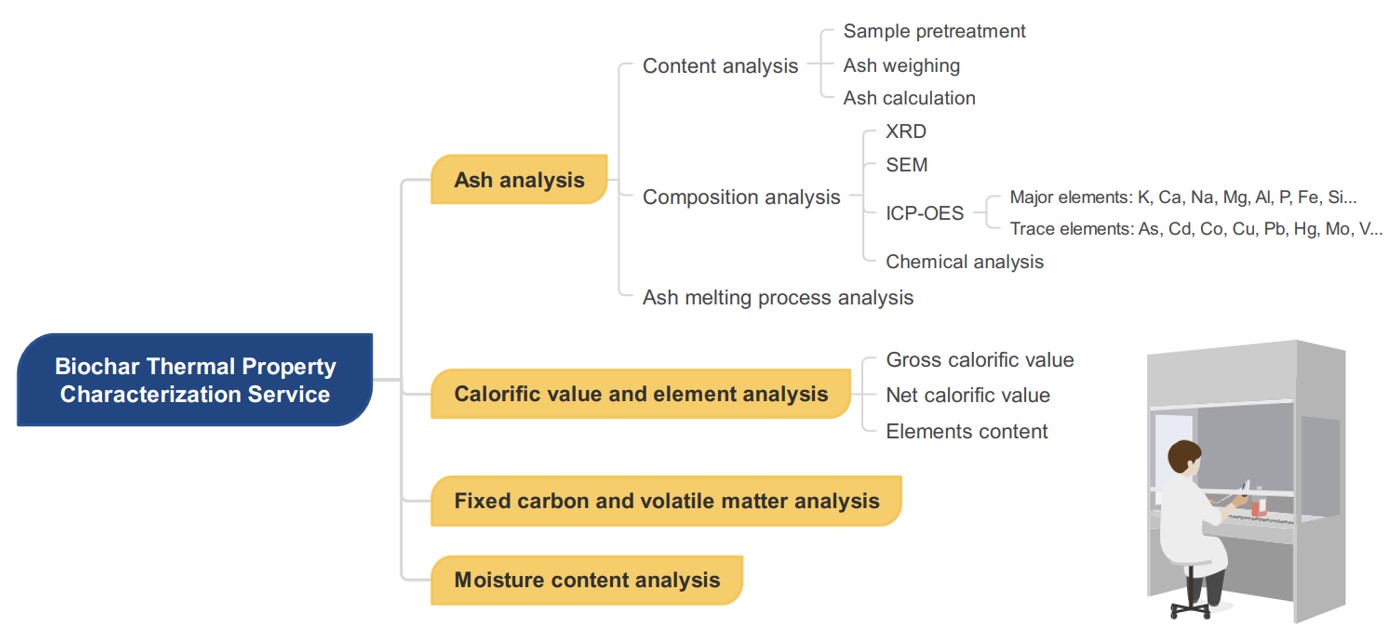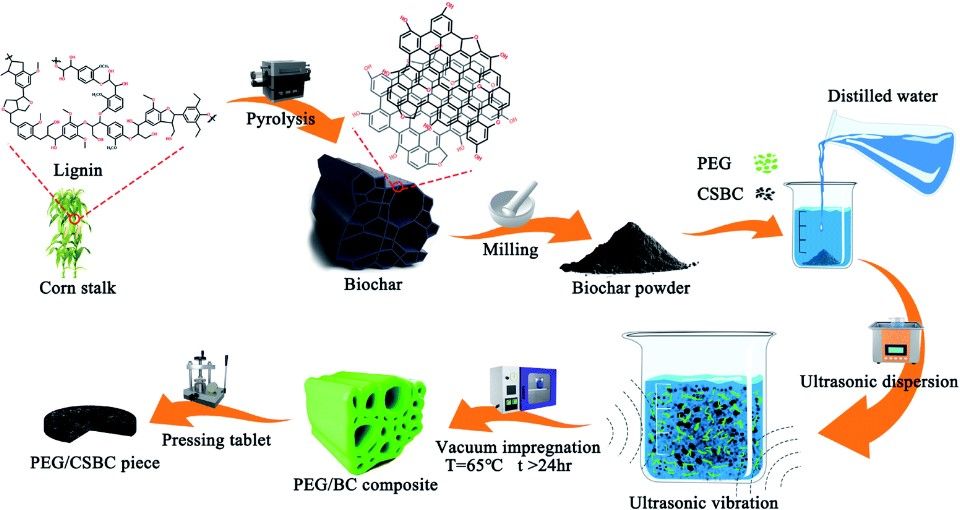Biochar Thermal Property Characterization Service
Professional Biochar Thermal Property Analysis Service at Creative Biolabs
Biochar is a carbonaceous product obtained by pyrolysis of biomass under high-temperature conditions. The purpose of thermal property characterization is to fully understand its behavior characteristics at high temperatures, including thermal stability, thermal decomposition characteristics, etc., to evaluate its application potential in energy utilization, soil improvement, environmental remediation, and other fields. Creative Biolabs has professional knowledge and project experience in the field of biochar. Our expert team has comprehensive analysis capabilities and combines thermal property data with other property data (such as Physical Properties and Soil Amendment Properties) to optimize the preparation process of biochar and provide clients with comprehensive biochar property evaluation and custom solutions.
-
Ash content and composition analysis
Ash is the sum of inorganic minerals and metal oxides remaining in biochar after burning or drying under high-temperature conditions. These inorganic substances usually include metal oxides, silicates, carbonates, etc. Ash content is an important quality indicator of biochar, and high ash content may reduce the quality and performance of biochar. By analyzing the ash composition, it is possible to determine the specific application areas suitable for biochar, such as soil improvement, environmental remediation, or energy utilization. We provide mature ash content and composition analysis services.
-
Ash content analysis
-
Sample pretreatment: We put the biochar sample into a hot box or furnace to burn off the organic matter at high temperatures, leaving an inorganic residue (ash).
-
Ash weighing: Then we weigh the residue to get the mass of the ash.
-
Ash calculation: Finally, by removing the mass change before and after the ash, we calculate the ash content in the biochar (usually expressed as a percentage).
-
Ash composition analysis
-
X-ray diffraction (XRD): It is used to identify and quantitatively analyze the crystal structure in the ash and determine the mineral composition.
-
Scanning electron microscopy (SEM): It is used to observe the microscopic morphology of the ash and help identify different particles.
-
Inductively coupled plasma-optical emission spectroscopy (ICP-OES): It is mainly used to analyze the elemental composition of the ash, including major elements (such as potassium, calcium, sodium, magnesium, aluminum, phosphorus, iron, silicon) and trace elements (such as arsenic, cadmium, cobalt, copper, lead, mercury, molybdenum, vanadium).
-
Chemical analysis: Moreover, some chemical methods, such as acid leaching extraction, also analyze the different components in the ash.
-
Ash melting process analysis
In addition, we also analyze the ash melting behavior of biochar. We use ash melting instrument equipment to heat the sample under controlled experimental conditions and observe its melting process, recording parameters such as the starting temperature, deformation temperature, and flow temperature. Subsequently, through data analysis and result interpretation, we understand the stability and behavior characteristics of biochar ash under high-temperature conditions, to predict and evaluate the problems that may arise in the industrial process and guide product design and production process optimization.
-
Calorific value and element analysis
Analyzing the calorific value and elements of biochar is a key evaluation step in evaluating whether biochar is used as fuel. We usually use calorimeters or thermodynamic methods to determine the energy released by biochar when it is burned, including parameters such as gross calorific value and net calorific value. We usually use ICP-OES or inductively coupled plasma mass spectrometry (ICP-MS) to determine the content of major elements such as carbon, hydrogen, nitrogen, oxygen, and sulfur in biochar samples. These analyses help to evaluate the composition characteristics of biochar, thereby providing a basis for its energy utilization potential.
-
Fixed carbon and volatile matter analysis
We use a thermal analyzer or a thermogravimetric-differential thermal analyzer to heat the biochar sample and measure the weight loss within a certain temperature range to determine the volatile matter content. Subsequently, the fixed carbon content is determined by calculating the mass percentage of the residue. This analysis process evaluates the combustion characteristics, stability, and carbon storage capacity of biochar, providing important data support for product quality control, process improvement, and application field selection, which helps to promote the effective application of biochar in energy, soil improvement, and other fields.
-
Moisture content analysis
In addition, we also provide biochar moisture content determination services through the constant weight method, which provides important data support for product quality control and storage conditions selection.

Creative Biolabs' experienced technical team provides clients with accurate and reliable biochar thermal property analysis services. In addition, we also provide Biochar Manufacturing services. Please contact us in time if you would like to get more details.
Published data
Biochar is a material that can be sustainably obtained from biomass. It has a wide range of sources and has a porous structure, high specific surface area, and high thermal conductivity. Therefore, it has been widely applied in the development of energy storage materials. Biochars prepared from different biomass sources have different structural properties, resulting in significant differences in their energy storage capacity as phase change materials. In this study, the authors used corn straw as a raw material to prepare corn straw biochar (CSBC) and mixed it with polyethylene glycol (PEG) by ultrasound-assisted vacuum impregnation to form a shape-stable composite material. In addition, they also systematically analyzed and fully characterized the production process of biochar, pyrolysis behavior, and thermal properties of PEG/CSBC composites. The results showed that the composite material had good morphological stability and high thermal storage stability, which was a high-performance green energy storage material with great potential.
 Fig.1 Preparation process of CSBC and PEG/CSBC composites.1, 2
Fig.1 Preparation process of CSBC and PEG/CSBC composites.1, 2
FAQs
Q1: How does the calorific value of biochar relate to its quality?
A1: Calorific value is an important indicator of the energy utilization potential of biochar. Our thermal property analysis will help clients evaluate the combustion performance and calorific value level of biochar.
Q2: Does your thermal property analysis service cover multiple types of biochar?
A2: We focus on thermal property analysis of various types of biochar samples and provide custom testing solutions according to different needs to ensure that client requirements are met.
Q3: How do you ensure the data accuracy of your thermal property analysis service?
A3: We use advanced testing equipment and standardized methods for thermal property analysis to ensure that the data is accurate and reliable to meet client needs and industry standard requirements.
Customer Review
Combustion Performance Analysis Results Guide Client Project Planning
"Thanks to the Creative Biolabs team for providing us with reliable thermal property analysis services. The combustion characteristics evaluation results played a key role in the planning of our project. Looking forward to working with you again!"
Quickly Respond to Clients' Thermal Performance Analysis Needs
"The thermal property analysis report provided by Creative Biolabs was detailed and professional. The attention and response speed to client needs were impressive. Highly recommend their services!"
References
-
Liu, Shiwang, et al. "Effects of biochar pyrolysis temperature on thermal properties of polyethylene glycol/biochar composites as shape-stable biocomposite phase change materials." RSC advances 12.16 (2022): 9587-9598.
-
Under Open Access license CC BY 3.0, without modification.
For Research Use Only.
Related Services


 Fig.1 Preparation process of CSBC and PEG/CSBC composites.1, 2
Fig.1 Preparation process of CSBC and PEG/CSBC composites.1, 2

